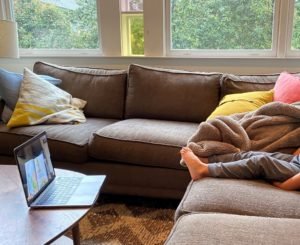I often wonder how people stayed in touch and felt connected with faraway family and friends before email and smartphones became so commonplace. Communications were limited to letters or landline telephones, and people didn’t have the opportunity to video call to see each other’s expressions or send a photo via text message or email to share what they were up to.
Now, I regularly send and receive video and photo messages and video call with my loved ones. My young children don’t miss a beat when they see their grandparents, aunts, uncles, and cousins that don’t live nearby because they are used to regularly talking with them “face”-to-“face” (or should I say screen-to-screen?) and feel very familiar with people they don’t get to see very often.
Virtual Connections
When the pandemic first started and we were all confined to our homes, my quarantine bubble consisted of my spouse, our dog, a newborn baby born during the first week of lockdown, and an energetic three-year-old. Our family and friends all met our quarantine baby virtually via FaceTime and got to know her through virtual calls, pictures, and videos.
We had virtual game nights with family and happy hours with friends – even those that live in the same neighborhood. My son and his best buddies would show each other their toys, sing, and be silly while on video calls together. While it wasn’t the same as being together in-person, we were all so grateful for the ability to connect, see each other, and continue to share moments together.

Social connections are vital to all of us regardless of our age and play a key role in our overall health and wellbeing. The need to physically distance ourselves from our family, friends, and communities to prevent the spread of COVID-19 has challenged all of us in different ways over the past year and a half, but thankfully, many of us have found ways to connect with others from the safety of our own homes. The ability to call in to a neighborhood meeting helped some of us engage with our neighbors in ways we couldn’t before, whether homebound, juggling caregiving duties, or isolating due to an illness. We caught up with out-of-town friends we haven’t seen in years because people became more comfortable having video conversations.
Tapping Into Technology to Stay Connected and Engaged, published by engAGED: The National Resource Center for Engaging Older Adults together with the Eldercare Locator and Older Adults Technology Services (OATS), provides an overview of the various platforms, devices, assistive technology, and resources and shares tips to help you engage with others using technology.
FaceTime Story Time
During lockdown, my three-year-old’s daycare was closed, so I tried to fill his days with a mix of learning, creating, playing, and downtime (he refused to nap once he turned three). Thankfully, every day after lunch while the baby was napping, FaceTime story time came to my rescue so I could have a little bit of time to myself for a nap or shower.

My parents, who are retired and live in another state, and my son would get on FaceTime together and select books from my parents’ collection of children’s books. Usually, one grandparent would go first and read one or two books with him, and then the other grandparent would do the same. It wasn’t always only books either – they’d show each other things around their respective homes, or pop outside to observe nature, or simply chat about anything and everything. I honestly am not sure what transpired on most days because I was often in another room.
The three of them all enjoyed their daily routine and grew their relationships in new ways. Some days, they’d be on FaceTime for 20 minutes, and other days, their video call would stretch longer than an hour.
Technology as Part of Our New Normal
Now daycares, schools, community centers, workplaces, libraries, etc. have reopened with COVID-19 safety measures, and people aren’t staying home as much. But the desire to feel a regular connection with our loved ones and communities remains.
Technology will continue to be important for many of us to connect and engage with our communities, friends, and families in our daily lives. While many virtual options were born out of necessity to protect people from the spread of COVID-19, new doors were opened for many people who hadn’t considered using technology to connect with others.
At my house, we still regularly video call with family and friends, and my quarantine-baby-now-toddler walks all over the house holding the phone, babbling away, and guarding the phone close to her body if someone else tries to have a turn. We all light up when we hear the familiar ring of an incoming video call.
I encourage everyone to explore new ways that you can engage in your community and embrace technology as a tool to help you stay connected with loved ones. There are many devices and platforms out there; explore Tapping Into Technology to Stay Connected and Engaged to help you get started.



